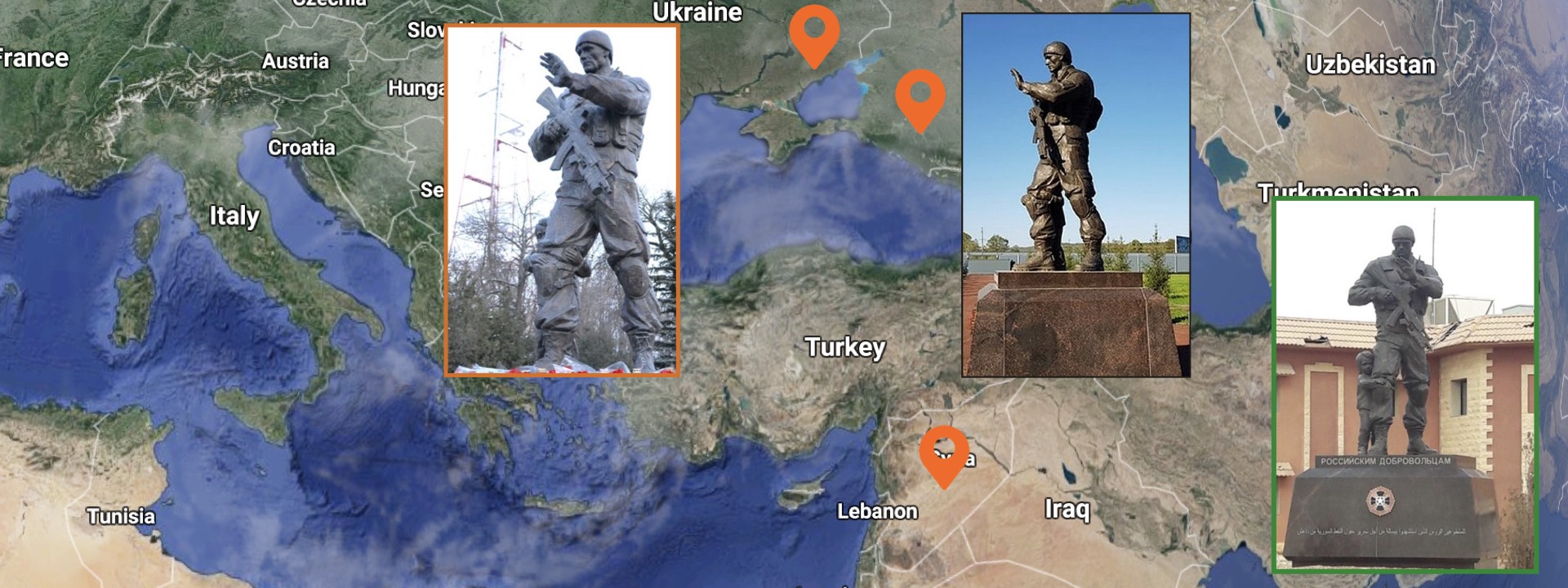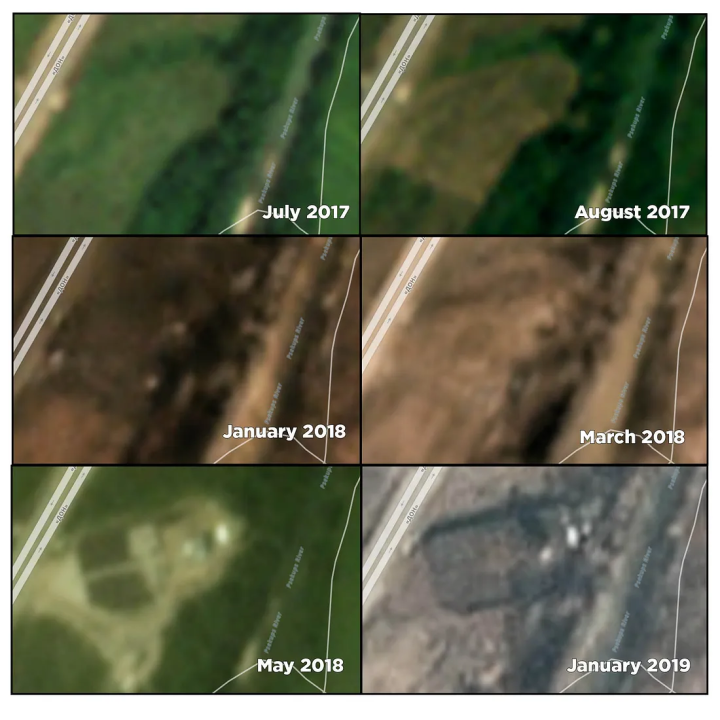#PutinAtWar: Krasnodar Joins Dead Mercenaries Society
Third identical statue commemorating fallen Wagner mercenaries erected in Krasnodar, Russia.
#PutinAtWar: Krasnodar Joins Dead Mercenaries Society

BANNER: (Source: Google Maps, background; @DFRLab, left, right; @bad_moskal/archive, middle)
In late November 2018, pictures appeared on Russian social media platform VKontakte (VK) of a statue commemorating mercenaries from the Wagner Group, a private military company, in an undisclosed location in Russia.
Using open-source information, @DFRLab confirmed that the statue is located in Russia’s Krasnodar region, only a few dozen kilometers from Wagner’s training facilities in Molkino. The new statue further confirms the geographic scope of the Wagner Group as well as the group’s recognition that physical representations of its soldiers carry emotional resonance.
In March 2018, @DFRLab reported that two statues commemorating fallen Wagner mercenaries were erected in Palmyra, Syria, and Luhansk, Ukraine. These statues suggest the presence of mercenary activity in these countries. The use of private military forces is prohibited in Russia, and the Kremlin has not publicly admitted such activity, repeatedly denying the use of Wagner soldiers in foreign military conflicts. Their suspected areas of operation, however, include Syria and Ukraine as well as various African countries.
Krasnodar
One of the first tweets showing the newly erected statue appeared on November 23, 2018, on Twitter. The tweet mentioned that the new statue was built in Goryachy Klyuch (Горячий ключ), a small town in Russia’s Krasnodar region.
The tweet contained three images, with the statue clearly visible in two of them. Upon comparison with the images of the statues that @DFRLab previously covered, the statue clearly matched the ones in Ukraine and Syria, including the pedestal and the Wagner cross logo on it.

Meanwhile, the other two photographs revealed geolocation details that helped to find the exact location. The photos showed that the statue had been erected in front of a new Orthodox chapel, surrounded by a high fence. This complex was easily located using satellite imagery, due to its distinct shape and its description in the source social-media post. The chapel complex is located next to the northern entrance of the city of Goryachy Klyuch.

Moreover, the Wagner boot camp and training grounds are located just a few dozen kilometers north of this location, near the small town of Molkino.

The key structure in the geolocation process was the Orthodox chapel, as the chapel’s architectural style suggests it is a recent addition.

On January 14, 2019, BBC Russian Service looked into the story behind the chapel, which was reportedly built in the summer of 2018. According to BBC’s report, the chapel complex was constructed by Megaline LLC, a company closely affiliated with Yevgeny Prigozhin, a Russian billionaire dubbed “Putin’s Chef” due to his catering company’s ties to the Kremlin. He reportedly oversees the activities of the Wagner Group and was indicted by U.S. Special Prosecutor Robert Mueller for allegedly financing the Internet Research Agency, which ran a large-scale influence campaign targeting the United States from 2014 onwards and which interfered in the U.S. presidential election in 2016.
Confirmation by Social Media
To verify the geolocation of the chapel, @DFRLab cross-checked the geolocation coordinates with photos and posts found on VK. In order to optimize the VK search in the area of interest, @DFRLab uploaded a photo to a research account used solely for this purpose and manually geotagged it to match the location of interest. This manipulation allowed @DFRLab to compile all of the photos geotagged to that area, which we used to further confirm the location.

By cross-checking VK photos of the location against satellite imagery, @DFRLab established a timeline for the construction of the chapel. By August 2018, the Orthodox chapel was fully constructed.

On July 2, a VK user posted a photo taken from a passing train, showing the chapel in the background. The photo corroborates @DFRLab’s construction timeline, as it shows the chapel is still covered in scaffolding, which was only taken down in August 2018.

Lastly, monthly satellite imagery was used to track the timeline of the construction. Imagery suggested that work started as early as August 2017, when the lot was already cleared for construction. In January 2018, the first constructed objects were already visible, and by March 2018, the foundations of the chapel had been laid. By May 2018, the lot had been fenced and a roof for the chapel built.

Conclusion
The Wagner Group’s presence continues to be identified in various countries and continents. As its activity grew, mercenary losses grew as well, leading to the commemoration of the group’s soldiers throughout 2018. As of now, three identical statues commemorating Wagner soldiers have been identified in Ukraine, Syria, and Russia. The statue built in Luhansk, Ukraine, likely honors Wagner mercenaries that fought and died in the Donbas region. The statue in Palmyra, Syria, commemorates the fighters that fought “ISIS and recovered oil fields.” Lastly, the latest geolocated and verified statue was constructed near Goryachy Klyuch in the Krasnodar region of Russia. Together with the chapel, this newest statue is only a few dozen kilometers away from Wagner Group’s boot camp.
The locations of the statues appear deliberately selected to maximize their symbolic impact and to make the political point of Russia’s engagement in these conflicts. They also point to the reality of conflict for the soldiers themselves. The location of this third statue in Russia itself, close to the Wagner boot camp, suggests a desire on the part of those who came back from the war to commemorate those who did not.
@DFRLab will continue to monitor significant Russian operations, exercises, and military developments.
Cite this case study:
Lukas Andriukaitis, “PutinAtWar: Krasnodar Joins Dead Mercenaries Society,” Digital Forensic Research Lab (DFRLab), March 14, 2019, https://dfrlab.org/2019/03/14/putinatwar-krasnodar-joins-dead-mercenaries-society/.

